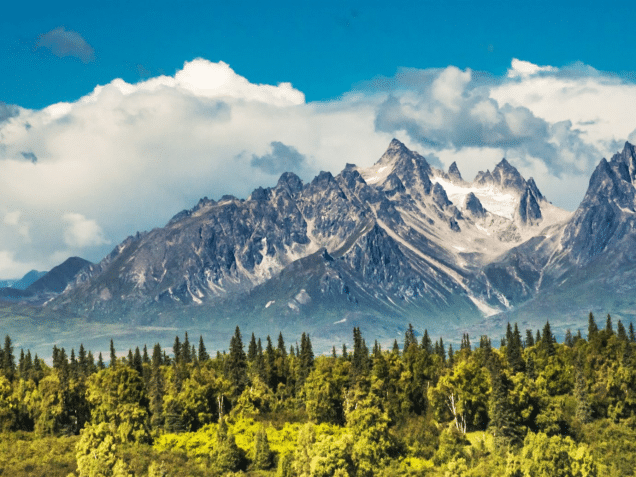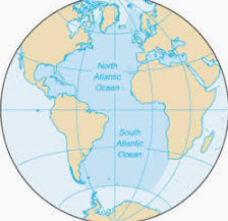Mountains and Oceans
Grade 5 Science Worksheets
A mountain is a large natural landform that rises at least 300 meters or more above the adjoining areas. It is usually characterized by steep sloping sides, sharp or rounded ridges and a high point called a peak. A mountain range is a chain of mountains that are close together. Mountains are formed due to tectonic forces or volcanism. Hills, on the other hand, are natural elevated lands formed due to faulting or erosion. They are less steep, have lower altitudes with a rounded top. Mount Everest, at 8848 m, is the highest mountain peak in the world which is a part of the Himalayan Mountain range.

Schedule a Free session to clear worksheet doubts
No credit card required, no obligation to purchase.
Just schedule a FREE Sessions to meet a tutor and get help on any topic you want!

On the other hand, Ocean is a large body of water, which basically constitutes a major chunk of the earth’s hydrosphere. They are saline in nature and cover over 71% of the earth’s surface and 97% of Earth’s water. They are responsible for controlling the weather and climate of the earth. The continents are separated by oceans. The various oceans, in descending order by area are Pacific, Atlantic, Indian, Southern (Antarctic) and Arctic Ocean.
Both Mountains and Oceans are habitats to millions of species, known and unknown.
Types of Mountains
Mountains are basically divided into three kinds based on their origins and physical appearances:
1) The Fold Mountains:
Fold Mountains are formed when two plates collide head-on and the earth’s crust folds and rises as a result. This can be compared to a paper that folds on being pushed from each side. Anticlines and synclines are the up and down folds that are caused by such compressional stress. They are the most common types of mountains. Examples of Fold Mountains include The Rockies in North America, The Andes in South America, and the Himalayas in Asia.


The Rockies in North America
Learn more about Mountains and Oceans and other important topics with 5th Grade Science Tutoring at eTutorWorld. Our expert science tutors break down the topics through interactive one-to-one sessions. We also offer the advantage of customized lesson plans, flexible schedules and convenience of learning from home.
eTutorWorld Understands Math Tutoring | Online Math Worksheets are Important Tools
Understanding graphs, charts, and opinion polls in a newspaper, for calculating house and car payments, and for choosing a long-distance telephone service are impossible without strong math skills …and the only way to develop strong math skills is by constant practice.
‘Practice makes a man perfect’ holds true for no other field better than for math. A middle or high school student must set aside a minimum of an hour for math every day. Other than textbooks, worksheets help you revise and understand concepts better.
Our expert tutors prepare online maths worksheets that are age and grade-appropriate. Grade-wise math worksheets for Elementary Math, Arithmetic, Pre-Algebra, Algebra, Geometry, Trigonometry, Statistics, Pre-Calculus and Calculus can be solved to improve math skills, to get ahead or to even catch up.
You may download these FREE online math worksheets in the PDF format, and then print and email us their solutions for a free evaluation and analysis by eTutorworld’smath expert tutors.
You may solve these worksheets by yourself or with your peers while studying together.
The Answer Key at the end of each worksheet allows for a self-evaluation.
Personalized Online Tutoring
eTutorWorld offers affordable one-on-one live tutoring over the web for Grades K-12, Test Prep help for Standardized tests like SCAT, CogAT, MAP, SSAT, SAT, ACT, ISEE and AP. You may schedule online tutoring lessons at your personal scheduled times, all with a Money-Back Guarantee. The first one-on-one online tutoring lesson is always FREE, no purchase obligation, no credit card required.
For answers/solutions to any question or to learn concepts, take a FREE CLASS.
No credit card required, no obligation to purchase.
Just book a free class to meet a tutor and get help on any topic you want!
2) Fault-Block Mountains:
Fault Block Mountains are formed when faults or cracks in the earth’s crust force blocks of rocks up and others down. This movement of huge blocks of rocks forces the earth’s crust to move apart and block of rocks end up stacking on top of one another forming a mountain. A horst represents a block pushed upward and a graben is a block that has been lowered relative to the blocks on either side due to the faulting. An example of Fault Mountains is Sierra Nevada Mountain in North America, the Harz Mountains in Germany.


Sierra Nevada Mountains
3) Volcanic Mountains:
Volcanic Mountains are formed from the eruption of molten material called magma through vents on the earth’s surface. These include lava, ashes, and rocks that pile up forming a mountain-like structure. Some famous examples of volcanic mountains are Mount Kilimanjaro in Africa and Mount Saint Helens in the state of Washington, among others.


Mt Kilimanjaro in Africa
Schedule a Free session to clear worksheet doubts
No credit card required, no obligation to purchase.
Just schedule a FREE Sessions to meet a tutor and get help on any topic you want!
Oceans
The World Ocean is a term used to denote the interconnected system of Earth’s oceanic waters. It is divided into five principal oceanic areas that are delimited by continents and other features in the oceans. They are-
I. Pacific Ocean
ii. Atlantic Ocean
iii. Indian Ocean
iv. Southern Ocean
v.Arctic Ocean
1) Pacific Ocean
The Pacific Ocean is the largest and the deepest World oceanic division. It extends from the Arctic Ocean and ends in the Southern Ocean in the south. It is bounded by various continents which includes Asia in the west and America in the east. It covers 46% of the earth’s water surface. It provides low-cost sea transportation between East and West. It has enormous fishing grounds, offshore oil fields, minerals, and also provides sand and gravel for the construction industry.


Californian coast in the Pacific
2) Atlantic Ocean
It is the second-largest ocean and covers approximately 20% of the earth’s surface. It covers about 29% of the water surface area. The Atlantic Ocean is surrounded by North and South America. The famous Bermuda Triangle, the area between Miami, Bermuda, and Puerto Rico is located here. The Atlantic Ocean drives our weather patterns and it is home to many species like dolphins, leatherback sea turtle, Bluefin tuna, and sea turtles. It is also an important key to many trades and travels between Europe and America.


3) Indian Ocean
The Indian Ocean is the third largest and the warmest among the oceans. It is bounded by Asia in the north, Africa in the west, and Australia in the east. Due to high temperatures, it has limited ability to support sea life. The Northern Indian Ocean is the most important transport route for oil as it connects the oil-rich countries of the Middle East with Asia.


4) Southern Ocean
The southern ocean is the world’s fourth-largest ocean. It is located in the South Pole along the Antarctic circle in the southern hemisphere. It is home to the beautiful emperor penguins, wandering albatrosses, blue whales, and fur seals. The low temperatures do not deter tourists from exploring the area during special expeditions.


Schedule a Free session to clear worksheet doubts
No credit card required, no obligation to purchase.
Just schedule a FREE Sessions to meet a tutor and get help on any topic you want!
5) Arctic Ocean
It is the smallest and the coldest of the oceans. The Arctic Ocean is situated in the northernmost part of the earth and it encompasses the North Pole and the adjoining polar region. The Arctic Ocean is roughly 8% the size of the Pacific Ocean and covers 4% of the earth’s surface. There is a wide variety of marine life in the Arctic Ocean including Polar bears, varieties of species of whales like bowhead, grey, narwhal, beluga, and varieties of seals.


Oceans are critical to life on Earth. But exploitation of the resources, overfishing and global warming are a threat to these beautiful vast bodies of water.
Check Point
Fill in the blanks:
- _____________are large natural landforms that rise above the surrounding areas.
- __________is the highest mountain peak in the world.
- Two examples of volcanic mountains are __________
- There are __________oceans in the world.
- __________is the smallest and coldest of all the oceans.
Answer Key
- Mountains or hills
- Mount Everest
- Mount Kilimanjaro and Mount Saint Helens
- Five
- Arctic Ocean
Schedule a Free session to clear worksheet doubts
No credit card required, no obligation to purchase.
Just schedule a FREE Sessions to meet a tutor and get help on any topic you want!
Pricing for Online Tutoring
| Tutoring Package | Validity | Grade (1-12), College |
|---|---|---|
| 5 sessions | 1 Month | $139 |
| 1 session | 1 Month | $28 |
| 10 sessions | 3 months | $269 |
| 15 sessions | 3 months | $399 |
| 20 sessions | 4 months | $499 |
| 50 sessions | 6 months | $1189 |
| 100 sessions | 12 months | $2249 |
5th Grade Free Worksheets
- Galaxies
- The Solar System
- Planets
- Structure of Earth
- Plate Tectonics
- Earthquakes
- Volcano and Folded Mountains
- Mountains and Oceans
- Rocks and Fossils
- The Water Cycle
- What Causes Weather Patterns?
- Types of Precipitation
- Climate
- Difference between Weather and Climate
- Impact of Environmental Changes on Humans and Other Organisms
- Plants also Adapt
- Body Systems
- Skeletal System
- Human Nervous System
- Circulatory System
- Respiratory System
- Reproductive System
- Digestive System
- Excretory System
- Atomic Theory
- States of Matter
- Mixtures
- Chemical and Physical Changes
- Types of Energy
- Energy Transformations
- What is Electricity?
- Properties of Electricity
- Uses of Electricity
- Electrical Circuits
- What is Force?
- Newton’s Laws of Motion
Images Credit:
- https://wanderlands.org/why-going-for-a-retreat-in-the-mountains-is-best-for-your-mental-health/
- https://venturewell.org/ocean-pollution/
- https://www.radford.edu/jtso/GeologyofVirginia/Structures/GeologyOfVAStructures4-2e.html
- https://en.wikipedia.org/wiki/Rocky_Mountains
- https://en.wikipedia.org/wiki/Horst_(geology)
- http://www.pitt.edu/~cejones/GeoImages/3IntrusiveBodies/1Plutonsz/1SierraNevada.html
- https://www.khanacademy.org/partner-content/amnh/earthquakes-and-volcanoes/volcanoes/a/volcanoes-magma-rising
- https://www.worldwildlife.org/blogs/good-nature-travel/posts/ten-interesting-facts-about-mt-kilimanjaro
- https://en.wikipedia.org/wiki/Pacific_Ocean
- https://www.kpbs.org/news/2011/jun/24/california-coast-vital-pacific-oceans-top-predator/
- https://en.wikipedia.org/wiki/Atlantic Ocean
- https://www.downtoearth.org.in/news/climate-change/ocean-floor-disintegrating-rapdily-due-to-manmade-co2-62037
- https://en.wikipedia.org/wiki/Indian_Ocean
- https://www.lowyinstitute.org/the-interpreter/french-perspective-australia-s-role-indian-ocean
- https://en.wikipedia.org/wiki/Southern_Ocean
- https://phys.org/news/2012-02-insight-southern-ocean-food-web.html
- https://en.wikipedia.org/wiki/Arctic_Ocean
- https://www.worldwildlife.org/habitats/polar-regions
- https://wanderlands.org/why-going-for-a-retreat-in-the-mountains-is-best-for-your-mental-health/
- https://venturewell.org/ocean-pollution/
- https://www.radford.edu/jtso/GeologyofVirginia/Structures/GeologyOfVAStructures4-2e.html
- https://en.wikipedia.org/wiki/Rocky_Mountains
- https://en.wikipedia.org/wiki/Horst_(geology)
- http://www.pitt.edu/~cejones/GeoImages/3IntrusiveBodies/1Plutonsz/1SierraNevada.html
- https://www.khanacademy.org/partner-content/amnh/earthquakes-and-volcanoes/volcanoes/a/volcanoes-magma-rising
- https://www.worldwildlife.org/blogs/good-nature-travel/posts/ten-interesting-facts-about-mt-kilimanjaro
- https://en.wikipedia.org/wiki/Pacific_Ocean
- https://www.kpbs.org/news/2011/jun/24/california-coast-vital-pacific-oceans-top-predator/
- https://en.wikipedia.org/wiki/Atlantic Ocean
- https://www.downtoearth.org.in/news/climate-change/ocean-floor-disintegrating-rapdily-due-to-manmade-co2-62037
- https://en.wikipedia.org/wiki/Indian_Ocean
- https://www.lowyinstitute.org/the-interpreter/french-perspective-australia-s-role-indian-ocean
- https://en.wikipedia.org/wiki/Southern_Ocean
- https://phys.org/news/2012-02-insight-southern-ocean-food-web.html
- https://en.wikipedia.org/wiki/Arctic_Ocean
- https://www.worldwildlife.org/habitats/polar-regions
IN THE NEWS

Our mission is to provide high quality online tutoring services, using state of the art Internet technology, to school students worldwide.
Online test prep and practice
SCAT
SSAT
ISEE
PSAT
SAT
ACT
AP Exam
Science Tutoring
Physics Tutoring
Chemistry Tutoring
Biology Tutoring
Math Tutoring
Pre-Algebra Tutoring
Algebra Tutoring
Pre Calculus Tutoring
Calculus Tutoring
Geometry Tutoring
Trigonometry Tutoring
Statistics Tutoring
Quick links
Free Worksheets
Fact sheet
Sales Partner Opportunities
Parents
Passive Fundraising
Virtual Fundraising
Our Expert Tutors
Safe and Secure Tutoring
Interactive Online Tutoring
After School Tutoring
Elementary School Tutoring
Middle School Tutoring
High School Tutoring
Home Work Help
Math Tutors New York City
Press
©2022 eTutorWorld Terms of use Privacy Policy Site by Little Red Bird
©2022 eTutorWorld
Terms of use
Privacy Policy
Site by Little Red Bird






